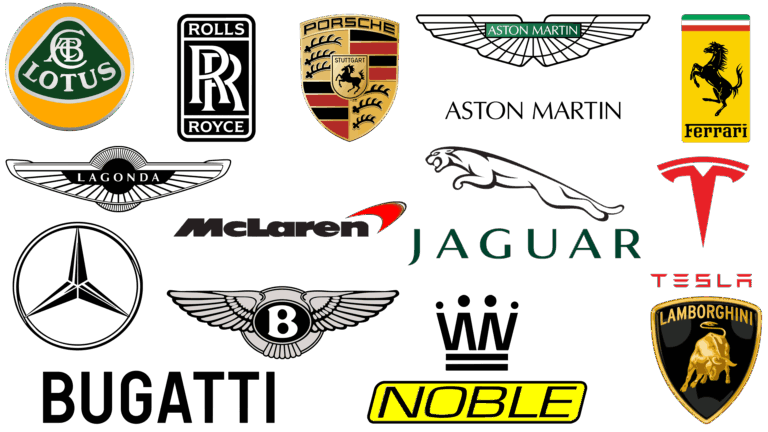Italian Sports Car Brands: A Symphony of Speed, Style, and Soul
Italian Sports Car Brands: A Symphony of Speed, Style, and Soul cars.truckstrend.com
The mere mention of "Italian sports cars" conjures images of blistering speed, breathtaking design, and an unparalleled sense of passion. More than just vehicles, these machines are rolling works of art, engineering marvels, and symbols of automotive excellence deeply rooted in a rich history of racing and innovation. Italian sports car brands represent the pinnacle of automotive craftsmanship, blending cutting-edge technology with an emotional appeal that few other nations can replicate. They are a testament to Italy’s enduring legacy in design, performance, and the sheer joy of driving.
This comprehensive guide will delve into the heart of Italian sports car culture, exploring the iconic brands that have shaped this legendary industry, dissecting their unique philosophies, and offering insights into what makes them so profoundly desirable.
Italian Sports Car Brands: A Symphony of Speed, Style, and Soul
The Quintessence of Italian Automotive Excellence
What sets Italian sports cars apart? It’s a confluence of factors, a unique blend of artistry, engineering prowess, and an unyielding commitment to performance. From the post-war boom that saw Italy rise as a global automotive powerhouse, fueled by a passion for motorsport, to the present day, Italian manufacturers have consistently pushed boundaries. They embody the "Made in Italy" philosophy, where quality, design, and bespoke craftsmanship are paramount. Every curve, every line, every engine note is meticulously crafted to evoke an emotional response, transforming a mere mode of transport into an exhilarating experience.
Key Players in the Italian Sports Car Arena
Italy is home to some of the most revered and recognizable sports car brands in the world, each with its distinct personality and heritage.
Ferrari: The Prancing Horse of Maranello
Born from the singular vision of Enzo Ferrari, the marque of the Prancing Horse is arguably the most famous and coveted sports car brand globally. Founded in 1929 as "Scuderia Ferrari" (Ferrari Racing Team), its primary purpose was to sponsor amateur drivers. It wasn’t until 1947 that Ferrari began producing road cars to fund its relentless racing ambitions.
- Identity: Synonymous with racing success, exclusivity, and an unmistakable Rosso Corsa (racing red) hue. Ferrari embodies pure, unadulterated performance coupled with timeless elegance.
- Iconic Models: The 250 GTO, F40, Enzo, LaFerrari, and the current 296 GTB and SF90 Stradale represent the pinnacle of their respective eras, blending groundbreaking technology with an unparalleled driving experience.
- Philosophy: "Built for the track, adapted for the road." Every Ferrari carries the DNA of its racing heritage, prioritizing driver engagement, acoustic symphony, and breathtaking speed. Owning a Ferrari is not just about possessing a car; it’s about entering an exclusive club and becoming part of a legend.

Lamborghini: The Raging Bull of Sant’Agata Bolognese
The story of Lamborghini is one of defiance and ambition. Ferruccio Lamborghini, a successful tractor manufacturer, famously confronted Enzo Ferrari about the clutch issues in his Ferrari. Dismissed by Enzo, Ferruccio vowed to build a better grand tourer himself. In 1963, Automobili Lamborghini was born.
- Identity: Bold, aggressive, flamboyant, and often outrageous in design. Lamborghini cars are statements, challenging conventions with their sharp angles, dramatic scissor doors, and powerful engines.
- Iconic Models: The Miura, often credited as the first modern supercar; the Countach, a poster car for a generation; the Diablo; and modern titans like the Aventador, Huracán, and the groundbreaking Urus SUV.
- Philosophy: While Ferrari focused on racing, Lamborghini aimed for luxurious, powerful grand tourers that stood out. Today, under Audi ownership, Lamborghini maintains its distinct "Raging Bull" persona, pushing boundaries in design and performance with a focus on raw, visceral experiences.

Maserati: The Trident of Elegance and Performance
With a history dating back to 1914, Maserati is one of the oldest and most storied Italian automotive brands. Initially focused on racing, the Maserati brothers eventually diversified into road cars, blending luxury, performance, and distinctive Italian flair.
- Identity: A sophisticated blend of sporting prowess and refined luxury. Maserati offers an alternative to the pure aggression of Lamborghini and the race-bred intensity of Ferrari, appealing to those who appreciate understated elegance combined with potent performance.
- Iconic Models: The 3500 GT, Ghibli (original and modern), Quattroporte, GranTurismo, and the recent MC20 supercar signify Maserati’s versatility across grand tourers, luxury sedans, and high-performance sports cars.
- Philosophy: "Luxury, sports, and style cast in exclusive cars." Maserati aims to deliver an exhilarating driving experience wrapped in an exquisitely crafted, comfortable, and stylish package. The distinct roar of a Maserati engine, often developed with Ferrari until recently, is instantly recognizable. The brand is currently undergoing a significant resurgence, with a strong focus on electrification and new performance models.
Alfa Romeo: The Heart of Sportiness
Alfa Romeo, founded in 1910, possesses a deep and passionate history intertwined with motorsport. Their motto, "La Meccanica delle Emozioni" (The Mechanics of Emotion), perfectly encapsulates their approach to car manufacturing.
- Identity: Driver-centric, passionate, and beautifully designed. Alfa Romeo cars are renowned for their exceptional handling, responsive engines, and an emotional connection with the driver that few brands can match.
- Iconic Models: The 8C Competizione, 4C, Giulia Quadrifoglio, and Stelvio Quadrifoglio represent modern interpretations of Alfa Romeo’s sporting DNA, delivering thrilling performance in more accessible packages than their supercar counterparts.
- Philosophy: To create cars that are a joy to drive, with an emphasis on balance, steering feel, and a distinctive engine note. While not always in the hypercar league, Alfa Romeo consistently delivers engaging sports cars and performance-oriented sedans and SUVs that stir the soul.
Pagani: The Art of Hypercars
The youngest of the major Italian sports car brands, Pagani Automobili was founded in 1992 by Horacio Pagani, an Argentine-Italian engineer who previously worked at Lamborghini. Pagani cars are not just vehicles; they are bespoke, handcrafted works of art, pushing the boundaries of design, materials science, and engineering to create hypercars of unparalleled exclusivity.
- Identity: Extreme craftsmanship, unparalleled attention to detail, and a blend of futuristic design with classical inspiration. Pagani vehicles are automotive sculptures, each component meticulously designed and executed.
- Iconic Models: The Zonda and its successor, the Huayra, are legendary for their incredible performance, unique aesthetics, and the use of exotic materials like carbo-titanium.
- Philosophy: "To create a car that is an extension of the soul." Pagani focuses on limited production, ensuring absolute exclusivity and a personalized experience for each owner. They represent the ultimate expression of automotive artistry and engineering.
Beyond the Superlatives: What Defines an Italian Sports Car?
While each brand has its unique flavor, several common threads weave through the fabric of Italian sports car manufacturing:
- Design Language: Italian design houses like Pininfarina, Bertone, and Italdesign have penned some of the most beautiful cars ever created. Italian sports cars are characterized by fluid lines, dramatic proportions, and an inherent sense of timeless beauty. Aerodynamics are not just functional; they are art.
- Engineering Prowess: Historically, Italian sports cars were defined by their high-revving, naturally aspirated engines, producing an intoxicating symphony of sound. While turbocharging and hybridization are now common, the focus remains on powerful, responsive powertrains and meticulously tuned chassis for exceptional handling.
- Driving Experience: The emphasis is always on driver engagement. Precise steering, firm but communicative suspension, and a direct connection between driver and machine are hallmarks. It’s about the visceral thrill, the sound, the feel, and the emotion.
- Exclusivity & Heritage: Many Italian sports cars are produced in limited numbers, contributing to their allure and often their collectibility. The rich racing heritage of these brands adds an invaluable layer of prestige and storytelling.
Owning an Italian Icon: Considerations and Challenges
While the allure is undeniable, owning an Italian sports car comes with its own set of considerations:
- High Purchase Price: These are luxury items, and their price tags reflect the extensive research and development, exotic materials, and specialized craftsmanship involved.
- Maintenance Costs: Due to their sophisticated engineering, specialized parts, and the need for expert mechanics, maintenance can be significantly more expensive than for conventional vehicles. Regular servicing is crucial to maintain performance and reliability.
- Insurance: High-value, high-performance vehicles command higher insurance premiums.
- Practicality: Many Italian sports cars prioritize performance and aesthetics over practicality. Low ground clearance, limited luggage space, and firm rides can make them challenging for daily driving in some environments.
- Depreciation: While some ultra-rare or classic models can appreciate, new sports cars generally depreciate, albeit often at a slower rate than mass-market vehicles due to demand and exclusivity.
Despite these challenges, for enthusiasts, the sheer joy, prestige, and emotional connection derived from owning and driving an Italian sports car often outweigh the financial commitment.
The Future of Italian Sports Cars
The automotive world is undergoing a seismic shift towards electrification and sustainability. Italian sports car brands are embracing this future, with hybrid models already in production (e.g., Ferrari SF90 Stradale, Lamborghini Sián) and fully electric vehicles on the horizon (e.g., Maserati GranTurismo Folgore, future Ferrari EVs). The challenge for these brands will be to maintain their distinctive character, emotional appeal, and performance heritage in a world of silent, electric powertrains. Innovation in sound design, lightweight materials, and advanced driving dynamics will be key to preserving the soul of the Italian sports car.
Practical Advice and Actionable Insights
For those captivated by Italian sports cars, here’s some advice:
- Experience Them: If ownership isn’t immediately feasible, seek opportunities to experience these machines. Visit automotive museums (like the Ferrari Museum in Maranello or the Lamborghini Museum in Sant’Agata Bolognese), attend car shows, or even consider high-performance driving experiences.
- Research Thoroughly: If considering a purchase, research specific models meticulously. Understand the total cost of ownership, including insurance, maintenance, and potential depreciation.
- Test Drive: Always test drive any vehicle you’re considering. The driving experience of an Italian sports car is unique, and you need to ensure it aligns with your expectations.
- Connect with Enthusiasts: Join owners’ clubs or online communities. These can be invaluable sources of information, advice, and camaraderie.
Concluding Summary
Italian sports car brands are more than just manufacturers; they are custodians of a passionate legacy, blending engineering prowess with unparalleled artistry. From Ferrari’s racing pedigree to Lamborghini’s audacious designs, Maserati’s elegant performance, Alfa Romeo’s driver-centricity, and Pagani’s bespoke hypercars, each brand contributes to a rich tapestry of automotive excellence. While ownership presents unique considerations, the allure of these machines—their captivating design, exhilarating performance, and undeniable soul—ensures their enduring appeal and their rightful place at the zenith of the automotive world. As they navigate the future of electrification, one thing remains certain: the heart of the Italian sports car will continue to beat with passion, innovation, and an unwavering commitment to the thrill of the drive.
Representative Price Table for Italian Sports Car Brands (New Models – Estimated Starting Prices)
Note: Prices are highly variable based on model year, specific trim, optional extras, market conditions, taxes, and region. These are approximate starting MSRPs for new models and should be used as a general guide only.
| Brand | Representative Model | Starting Price Range (USD – New) | Key Characteristic |
|---|---|---|---|
| Ferrari | 296 GTB | $340,000 – $400,000+ | Hybrid V6, modern performance, striking design |
| Roma | $220,000 – $260,000+ | Elegant GT, daily drivable Ferrari experience | |
| Lamborghini | Huracán Evo | $250,000 – $300,000+ | V10 power, aggressive styling, exhilarating drive |
| Urus | $230,000 – $280,000+ | Super SUV, powerful, luxurious, practical | |
| Maserati | MC20 | $220,000 – $260,000+ | Mid-engine supercar, Nettuno V6, carbon fiber chassis |
| GranTurismo (New) | $170,000 – $200,000+ | Luxury grand tourer, Nettuno V6 or upcoming EV | |
| Alfa Romeo | Giulia Quadrifoglio | $80,000 – $90,000+ | High-performance sedan, Ferrari-derived V6 |
| Stelvio Quadrifoglio | $85,000 – $95,000+ | Performance SUV, engaging driving dynamics | |
| Pagani | Huayra (Limited Editions) | $2,500,000 – $3,500,000+ | Bespoke hypercar, V12 engine, ultimate craftsmanship |
| Utopia | $2,700,000 – $3,000,000+ | Latest hypercar, manual transmission option, limited |
Frequently Asked Questions (FAQ) about Italian Sports Car Brands
Q1: Are Italian sports cars reliable?
A1: Modern Italian sports cars have significantly improved in reliability compared to their vintage counterparts. However, due to their high-performance nature, complex engineering, and exotic materials, they require specialized and often more frequent maintenance than regular cars. Proper care and adherence to service schedules are crucial for their longevity.
Q2: Why are Italian sports cars so expensive?
A2: Their high cost is due to several factors: extensive research and development for cutting-edge technology, use of lightweight and exotic materials (carbon fiber, titanium), limited production numbers that drive up exclusivity, bespoke craftsmanship (many parts are hand-assembled), and the immense brand prestige and heritage associated with these iconic marques.
Q3: What’s the main difference between Ferrari and Lamborghini?
A3: Historically, Ferrari focused on racing and built road cars to fund its motorsport endeavors, emphasizing driver connection and track performance. Lamborghini, founded out of a personal rivalry, aimed to build powerful, luxurious grand tourers that were more flamboyant and unconventional in design. While both now produce incredible supercars, Ferrari often maintains a slightly more refined, race-bred feel, while Lamborghini leans into bold, aggressive aesthetics and raw power.
Q4: Can I daily drive an Italian sports car?
A4: It depends on the specific model. Some (like the Ferrari Roma, Maserati GranTurismo, or Lamborghini Urus) are designed to be more comfortable and practical for daily use. However, traditional supercars (e.g., Ferrari 296 GTB, Lamborghini Huracán) often have low ground clearance, stiff suspensions, limited visibility, and high running costs, making them less ideal for everyday commuting, especially in congested areas or areas with poor roads.
Q5: Are Italian sports cars a good investment?
A5: For the most part, new Italian sports cars will depreciate like any other car, though often at a slower rate than mass-market vehicles due to their desirability and limited production. However, certain rare, limited-edition models or well-maintained classic examples can appreciate significantly over time, becoming highly sought-after collector’s items. It’s not a guaranteed investment and should be approached with careful research.
Q6: What is Pininfarina?
A6: Pininfarina is one of Italy’s most renowned automotive design houses (carrozzeria). For decades, they have designed some of the most iconic vehicles for brands like Ferrari, Alfa Romeo, and Maserati, shaping the aesthetic language of Italian sports cars. While some brands now do more in-house design, Pininfarina’s legacy is deeply embedded in the history of Italian automotive beauty.






